Impacts and Risk Assessments of Climate Change for the Yields of the Major Grain Crops in China, Japan, and Korea
Abstract
1. Introduction
2. Materials and Methods
2.1. Overview of the Study Area
2.2. Division of Crop Areas and Determination of the Growing Period
2.3. Data and Their Sources and Preprocessing Steps
2.4. Methods
2.4.1. Comprehensive Climate Factor
2.4.2. C-D-C Model
2.4.3. Impact Ratio of Climate Change
2.4.4. Climate Yields and Climate Loss
2.4.5. POT Model Based on the GPD
3. Results
3.1. Impacts of the Climate Factors on Grain Yields
3.1.1. OLS Estimation Results
3.1.2. Discussion of Multicollinearity
3.1.3. Discussion of Considering Technological Advancements
3.2. Impacts of Future Climate Change on Grain Yields
3.3. Risk Assessment of Grain Yields
3.3.1. Value at Risk (VaR) and Expected Shortfall (ES)
3.3.2. Sensitivity Analysis
4. Discussion
5. Conclusions
- (1)
- The effects of climate factors on grain yields vary greatly from region to region and from crop to crop, and the climate environments of regions significantly affected by climate factors tend to be unstable. The rice yields in Japan and Korea are mainly affected by climatic factors, while the rice yields in China are mainly affected by socioeconomic production factors. The wheat yields in China, Japan, and Korea are less significantly influenced by climate factors. Fertilizer application imposes a significant positive effect on the wheat yields in most crop areas. The ability of wheat to withstand the risk of climate change could be improved through rational fertilization. The spring maize area in northern China and the maize area in the Southwest China Mountainous are more affected by climate factors and less affected by socioeconomic factors.
- (2)
- Under future climate scenarios, climate change from 2021 to 2050 exerts a positive impact on the rice crop areas and wheat crop areas but a negative impact on the maize crop areas relative to the climate state from 1991 to 2020. The impact of climate under scenarios SSP1-2.6 or SSP5-8.5 on grain yields is greater than that under scenario SSP2-4.5.
- (3)
- For rice and maize, the risk of yield loss is higher in northern China than in southern China; regarding wheat, the risk of yield loss is higher in southern China than in northern China. This may be related to crop growth habits and the regional climate environment. The risks of yield losses in the Japan rice crop area, Japan wheat crop area, and Korea wheat crop area are relatively high. The risks of yield losses in the Japan maize crop area, Korea rice crop area, and Korea maize crop area are relatively low.
Author Contributions
Funding
Data Availability Statement
Acknowledgments
Conflicts of Interest
Appendix A
| Provincial-Level Administrative District | Fitted Curve 1 | R2 |
|---|---|---|
| Beijing | y = 112e−0.024x | 0.7410 |
| Tianjin | y = −21.11ln(x) + 143.01 | 0.8356 |
| Inner Mongolia | y = 3.0086x + 451.33 | 0.9054 |
| Jilin | y = 0.0412x3 − 2.6165x2 + 49.963x + 239.59 | 0.9399 |
| Heilongjiang | y = −0.5616x2 + 30.485x + 274.3 | 0.7244 |
| Zhejiang | y = −28.499x + 1532.9 | 0.9405 |
| Jiangxi | y = −0.9503x2 + 25.921x + 914.65 | 0.8269 |
| Henan | y = −0.0496x3 + 0.5159x2 + 47.899x + 2338.2 | 0.6863 |
| Guangxi | y = 0.0471x3 − 2.98x2 + 56.344x + 1252.5 | 0.8693 |
Appendix B
| Model | Institution and Description |
|---|---|
| ACCESS-CM2 | CSIRO (Commonwealth Scientific and Industrial Research Organisation, Aspendale, Victoria 3195, Australia), ARCCSS (Australian Research Council Centre of Excellence for Climate System Science). |
| ACCESS-ESM1-5 | CSIRO (Commonwealth Scientific and Industrial Research Organisation, Aspendale, Victoria 3195, Australia), ARCCSS (Australian Research Council Centre of Excellence for Climate System Science). |
| BCC-CSM2-MR | Beijing Climate Center, Beijing 100081, China |
| CanESM5 | Canadian Centre for Climate Modelling and Analysis, Environment and Climate Change Canada, Victoria, BC V8P 5C2, Canada |
| CMCC-CM2-SR5 | Fondazione Centro Euro-Mediterraneo sui Cambiamenti Climatici, Lecce 73100, Italy |
| CMCC-ESM2 | Fondazione Centro Euro-Mediterraneo sui Cambiamenti Climatici, Lecce 73100, Italy |
| IITM-ESM | Fondazione Centro Euro-Mediterraneo sui Cambiamenti Climatici, Lecce 73100, Italy |
| MIROC6 | JAMSTEC (Japan Agency for Marine-Earth Science and Technology, Kanagawa 236-0001, Japan), AORI (Atmosphere and Ocean Research Institute, The University of Tokyo, Chiba 277-8564, Japan), NIES (National Institute for Environmental Studies, Ibaraki 305-8506, Japan), and R-CCS (RIKEN Center for Computational Science, Hyogo 650-0047, Japan) |
| MPI-ESM1-2-HR | JAMSTEC (Japan Agency for Marine-Earth Science and Technology, Kanagawa 236-0001, Japan), AORI (Atmosphere and Ocean Research Institute, The University of Tokyo, Chiba 277-8564, Japan), NIES (National Institute for Environmental Studies, Ibaraki 305-8506, Japan), and R-CCS (RIKEN Center for Computational Science, Hyogo 650-0047, Japan) |
| MPI-ESM1-2-LR | JAMSTEC (Japan Agency for Marine-Earth Science and Technology, Kanagawa 236-0001, Japan), AORI (Atmosphere and Ocean Research Institute, The University of Tokyo, Chiba 277-8564, Japan), NIES (National Institute for Environmental Studies, Ibaraki 305-8506, Japan), and R-CCS (RIKEN Center for Computational Science, Hyogo 650-0047, Japan) |
| MRI-ESM2-0 | Meteorological Research Institute, Tsukuba, Ibaraki 305-0052, Japan |
| NESM3 | Nanjing University of Information Science and Technology, Nanjing, 210044, China |
| NorESM2-LM | NorESM Climate modeling Consortium consisting of CICERO (Center for International Climate and Environmental Research, Oslo 0349), MET-Norway (Norwegian Meteorological Institute, Oslo 0313, Norway), NERSC (Nansen Environmental and Remote Sensing Center, Bergen 5006, Norway), NILU (Norwegian Institute for Air Research, Kjeller 2027, Norway), UiB (University of Bergen, Bergen 5007, Norway), UiO (University of Oslo, Oslo 0313, Norway) and UNI (Uni Research, Bergen 5008, Norway), Norway. Mailing address: NCC, c/o MET-Norway, Henrik Mohns plass 1, Oslo 0313, Norway |
| NorESM2-MM | NorESM Climate modeling Consortium consisting of CICERO (Center for International Climate and Environmental Research, Oslo 0349, Norway), MET-Norway (Norwegian Meteorological Institute, Oslo 0313), NERSC (Nansen Environmental and Remote Sensing Center, Bergen 5006, Norway), NILU (Norwegian Institute for Air Research, Kjeller 2027, Norway), UiB (University of Bergen, Bergen 5007, Norway), UiO (University of Oslo, Oslo 0313) and UNI (Uni Research, Bergen 5008, Norway), Norway. Mailing address: NCC, c/o MET-Norway, Henrik Mohns plass 1, Oslo 0313, Norway |
| TaiESM1 | Research Center for Environmental Changes, Academia Sinica, Nankang, Taipei 11529, Taiwan, China |
References
- IPCC. Climate Change 2022: Impacts, Adaptation and Vulnerability; Cambridge University Press: Cambridge, UK, 2022; ISBN 978-1-00-932584-4.
- Rosenzweig, C.; Elliott, J.; Deryng, D.; Ruane, A.C.; Müller, C.; Arneth, A.; Boote, K.J.; Folberth, C.; Glotter, M.; Khabarov, N.; et al. Assessing Agricultural Risks of Climate Change in the 21st Century in a Global Gridded Crop Model Intercomparison. Proc. Natl. Acad. Sci. USA 2014, 111, 3268–3273. [Google Scholar] [CrossRef] [PubMed]
- Mehrabi, Z.; Ramankutty, N. Synchronized Failure of Global Crop Production. Nat. Ecol. Evol. 2019, 3, 780–786. [Google Scholar] [CrossRef] [PubMed]
- Wu, S.; Pan, T.; Liu, Y.; Deng, H.; Jiao, K.; Lu, Q.; Feng, A.; Yue, X.; Yin, Y.; Zhao, D.; et al. Comprehensive climate change risk regionalization of China. Acta Geogr. Sin. 2017, 72, 3–17. (In Chinese) [Google Scholar] [CrossRef]
- Li, K.; Wu, S.; Dai, E.; Xu, Z. Flood Loss Analysis and Quantitative Risk Assessment in China. Nat. Hazards 2012, 63, 737–760. [Google Scholar] [CrossRef]
- Xu, L.; Zhang, Q.; Zhou, A.; Huo, R. Assessment of Flood Catastrophe Risk for Grain Production at the Provincial Scale in China Based on the BMM Method. J. Integr. Agric. 2013, 12, 2310–2320. [Google Scholar] [CrossRef]
- Yue, Y.; Yang, W.; Wang, L. Assessment of Drought Risk for Winter Wheat on the Huanghuaihai Plain under Climate Change Using an EPIC Model-Based Approach. Int. J. Digit. Earth 2022, 15, 690–711. [Google Scholar] [CrossRef]
- Shi, P.; Ye, T.; Wang, Y.; Zhou, T.; Xu, W.; Du, J.; Wang, J.; Li, N.; Huang, C.; Liu, L.; et al. Disaster Risk Science: A Geographical Perspective and a Research Framework. Int. J. Disaster Risk Sci. 2020, 11, 426–440. [Google Scholar] [CrossRef]
- Wu, S.; Gao, J.; Deng, H.; Liu, L.; Pan, T. Climate change risk and methodology for its quantitative assessment. Prog. Geogr. 2018, 37, 28–35. (In Chinese) [Google Scholar] [CrossRef][Green Version]
- Holst, R.; Yu, X.; Gruen, C. Climate Change, Risk and Grain Yields in China. J. Integr. Agric. 2013, 12, 1279–1291. [Google Scholar] [CrossRef]
- Janetos, A.; Justice, C.; Jahn, M.; Obersteiner, M.; Glauber, J.; Mulhern, W. The Risks of Multiple Breadbasket Failures in the 21st Century: A Science Research Agenda; The Frederick S. Pardee Center for the Study of the Longer-Range Future, Boston University: Boston, MA, USA; International Food Policy Research Institute: Washington, DC, USA, 2017. [Google Scholar]
- Stojanovski, P.; Dong, W.; Wang, M.; Ye, T.; Li, S.; Mortgat, C.P. Agricultural Risk Modeling Challenges in China: Probabilistic Modeling of Rice Losses in Hunan Province. Int. J. Disaster Risk Sci. 2015, 6, 335–346. [Google Scholar] [CrossRef]
- Tigchelaar, M.; Battisti, D.S.; Naylor, R.L.; Ray, D.K. Future Warming Increases Probability of Globally Synchronized Maize Production Shocks. Proc. Natl. Acad. Sci. USA 2018, 115, 6644–6649. [Google Scholar] [CrossRef] [PubMed]
- Committee on Climate Change and China Expert Panel on Climate Change. UK-China Co-Operation on Climate Change Risk Assessment: Developing Indicators of Climate Risk; United Nations Office for Disaster Risk Reduction: Geneva, Switzerland, 2018. [Google Scholar]
- Surminski, S.; Di Mauro, M.; Baglee, J.A.R.; Connell, R.K.; Hankinson, J.; Haworth, A.R.; Ingirige, B.; Proverbs, D. Assessing Climate Risks across Different Business Sectors and Industries: An Investigation of Methodological Challenges at National Scale for the UK. Philos. Trans. R. Soc. A-Math. Phys. Eng. Sci. 2018, 376, 20170307. [Google Scholar] [CrossRef] [PubMed]
- Carrão, H.; Naumann, G.; Barbosa, P. Mapping Global Patterns of Drought Risk: An Empirical Framework Based on Sub-National Estimates of Hazard, Exposure and Vulnerability. Glob. Environ. Chang. 2016, 39, 108–124. [Google Scholar] [CrossRef]
- Chou, J.; Dong, W.; Xu, H.; Xu, G. New Ideas for Research on the Impact of Climate Change on China’s Food Security. Clim. Environ. Res. 2022, 27, 206–216. (In Chinese) [Google Scholar] [CrossRef]
- Wu, S.; Chao, Q.; Gao, J.; Liu, L.; Feng, A.; Deng, H.; Zuo, L.; Liu, W. Identification of Regional Pattern of Climate Change Risk in China under Different Global Warming Targets. J. Geogr. Sci. 2023, 33, 429–448. [Google Scholar] [CrossRef]
- Liu, W.; Ye, T.; Shi, P.; Chen, S. Advances in the study of climate change impact on crop producing risk. J. Nat. Disasters 2022, 31, 1–11. (In Chinese) [Google Scholar] [CrossRef]
- Finger, R.; Schmid, S. Modeling Agricultural Production Risk and the Adaptation to Climate Change. Agric. Financ. Rev. 2008, 68, 25–41. [Google Scholar] [CrossRef]
- Ling, X.; Zhang, Z.; Zhai, J.; Ye, S.; Huang, J. A Review for Impacts of Climate Change on Rice Production in China. Acta Agron. Sin. 2019, 45, 323–334. [Google Scholar] [CrossRef]
- Wang, X.; Jiang, Y.; Liu, Y.; Lu, J.; Yin, X.; Shi, L.; Huang, J.; Chu, Q.; Chen, F. Spatio-Temporal Changes of Rice Production in China Based on County Unit. Acta Agron. Sin. 2018, 44, 1704–1712. [Google Scholar] [CrossRef]
- Tong, P. Chinese Maize Planting Regionalization; China Agricultural Science and Technology Press: Beijing, China, 1992. (In Chinese) [Google Scholar]
- Mei, F.; Wu, X.; Yao, C.; Li, L.; Wang, L.; Chen, Q. Rice Cropping Regionalization in China. Chin. J. Rice Sci. 1988, 3, 97–110. (In Chinese) [Google Scholar] [CrossRef]
- Zhao, G. Study on Chinese Wheat Planting Regionalization (II). J. Triticeae Crops 2010, 30, 1140–1147. (In Chinese) [Google Scholar]
- Zhao, G. Study on Chinese Wheat Planting Regionalization (I). J. Triticeae Crops 2010, 30, 886–895. (In Chinese) [Google Scholar]
- Franch, B.; Cintas, J.; Becker-Reshef, I.; Sanchez-Torres, M.J.; Roger, J.; Skakun, S.; Sobrino, J.A.; Van Tricht, K.; Degerickx, J.; Gilliams, S.; et al. Global Crop Calendars of Maize and Wheat in the Framework of the WorldCereal Project. GIScience Remote Sens. 2022, 59, 885–913. [Google Scholar] [CrossRef]
- Thrasher, B.; Wang, W.; Michaelis, A.; Melton, F.; Lee, T.; Nemani, R. NASA Global Daily Downscaled Projections, CMIP6. Sci. Data 2022, 9, 262. [Google Scholar] [CrossRef] [PubMed]
- Thrasher, B.; Wang, W.; Michaelis, A.; Nemani, R. NEX-GDDP-CMIP6; NASA Center for Climate Simulation: Greenbelt, MD, USA, 2021. [CrossRef]
- Thrasher, B.; Maurer, E.P.; McKellar, C.; Duffy, P.B. Technical Note: Bias Correcting Climate Model Simulated Daily Temperature Extremes with Quantile Mapping. Hydrol. Earth Syst. Sci. 2012, 16, 3309–3314. [Google Scholar] [CrossRef]
- Chou, J.; Xu, Y.; Dong, W.; Xian, T.; Xu, H.; Wang, Z. Comprehensive Climate Factor Characteristics and Quantitative Analysis of Their Impacts on Grain Yields in China’s Grain-Producing Areas. Heliyon 2019, 5, e02846. [Google Scholar] [CrossRef] [PubMed]
- Chou, J.; Dong, W.; Feng, G. Application of an Economy-Climate Model to Assess the Impact of Climate Change. Adv. Atmos. Sci. 2010, 27, 957–965. [Google Scholar] [CrossRef]
- Chou, J.; Dong, W.; Ye, D. Construction of a Novel Economy-Climate Model. Chin. Sci. Bull. 2007, 52, 1006–1008. [Google Scholar] [CrossRef]
- Chou, J.; Ye, D. Assessing the Effect of Climate Changes on Grains Yields with a New Economy-Climate Model. Clim. Environ. Res. 2006, 11, 347–353. [Google Scholar]
- Chou, J.; Xu, Y.; Dong, W.; Zhao, W.; Li, J.; Li, Y. An Economy-Climate Model for Quantitatively Projecting the Impact of Future Climate Change and Its Application. Front. Phys. 2021, 9, 723306. [Google Scholar] [CrossRef]
- Chou, J.; Dong, W.; Feng, G. The Methodology of Quantitative Assess Economic Output of Climate Change. Chin. Sci. Bull. 2011, 56, 1333–1335. [Google Scholar] [CrossRef][Green Version]
- Dong, W.; Chou, J.; Feng, G. A New Economic Assessment Index for the Impact of Climate Change on Grain Yield. Adv. Atmos. Sci. 2007, 24, 336–342. [Google Scholar] [CrossRef]
- Lu, S.; Bai, X.; Li, W.; Wang, N. Impacts of Climate Change on Water Resources and Grain Production. Technol. Forecast. Soc. Change 2019, 143, 76–84. [Google Scholar] [CrossRef]
- Liu, Y.; Liu, B.; Yang, X.; Bai, W.; Wang, J. Relationships between Drought Disasters and Crop Production during ENSO Episodes across the North China Plain. Reg. Environ. Chang. 2015, 15, 1689–1701. [Google Scholar] [CrossRef]
- Balkema, A.A.; Haan, L. de Residual Life Time at Great Age. Ann. Probab. 1974, 2, 792–804. [Google Scholar] [CrossRef]
- Pickands, J., III. Statistical Inference Using Extreme Order Statistics. Ann. Stat. 1975, 3, 119–131. [Google Scholar] [CrossRef]
- Hosking, J.R.M.; Wallis, J.R. Parameter and Quantile Estimation for the Generalized Pareto Distribution. Technometrics 1987, 29, 339–349. [Google Scholar] [CrossRef]
- McNeil, A.; Saladin, T.; Zentrum, E. The Peaks over Thresholds Method for Estimating High Quantiles of Loss Distributions. In Proceedings of the 28th International ASTIN Colloquium, Cairns, Australia, 11–15 August 1997. [Google Scholar]
- Sun, Y.; Zhang, Y.; Zhang, X. Reconfiguring Star Inventors with Commercialization: A Case of the Graphene Sector. Scientometrics 2023, 128, 5411–5440. [Google Scholar] [CrossRef]
- Rockafellar, R.T.; Uryasev, S. Optimization of Conditional Value-at Risk. J. Risk 2000, 3, 21–41. [Google Scholar] [CrossRef]
- Zhou, L.; Turvey, C.G. Climate Change, Adaptation and China’s Grain Production. China Econ. Rev. 2014, 28, 72–89. [Google Scholar] [CrossRef]
- Heidarzadeh, M.; Iwamoto, T.; Takagawa, T.; Takagi, H. Field Surveys and Numerical Modeling of the August 2016 Typhoon Lionrock along the Northeastern Coast of Japan: The First Typhoon Making Landfall in Tohoku Region. Nat. Hazards 2021, 105, 1–19. [Google Scholar] [CrossRef]
- Hoerl, A.E.; Kennard, R.W. Ridge Regression: Biased Estimation for Nonorthogonal Problems. Technometrics 1970, 12, 55–67. [Google Scholar] [CrossRef]
- Sun, P.; Zou, Y.; Yao, R.; Ma, Z.; Bian, Y.; Ge, C.; Lv, Y. Compound and Successive Events of Extreme Precipitation and Extreme Runoff under Heatwaves Based on CMIP6 Models. Sci. Total Environ. 2023, 878, 162980. [Google Scholar] [CrossRef] [PubMed]
- Chou, J.; Xian, T.; Dong, W.; Xu, Y. Regional Temporal and Spatial Trends in Drought and Flood Disasters in China and Assessment of Economic Losses in Recent Years. Sustainability 2019, 11, 55. [Google Scholar] [CrossRef]
- Ha, T.T.V.; Fan, H.; Shuang, L. Climate Change Impact Assessment on Northeast China’s Grain Production. Environ. Sci. Pollut. Res. 2021, 28, 14508–14520. [Google Scholar] [CrossRef] [PubMed]
- Xu, Y.; Chou, J.; Yang, F.; Sun, M.; Zhao, W.; Li, J. Assessing the Sensitivity of Main Crop Yields to Climate Change Impacts in China. Atmosphere 2021, 12, 172. [Google Scholar] [CrossRef]

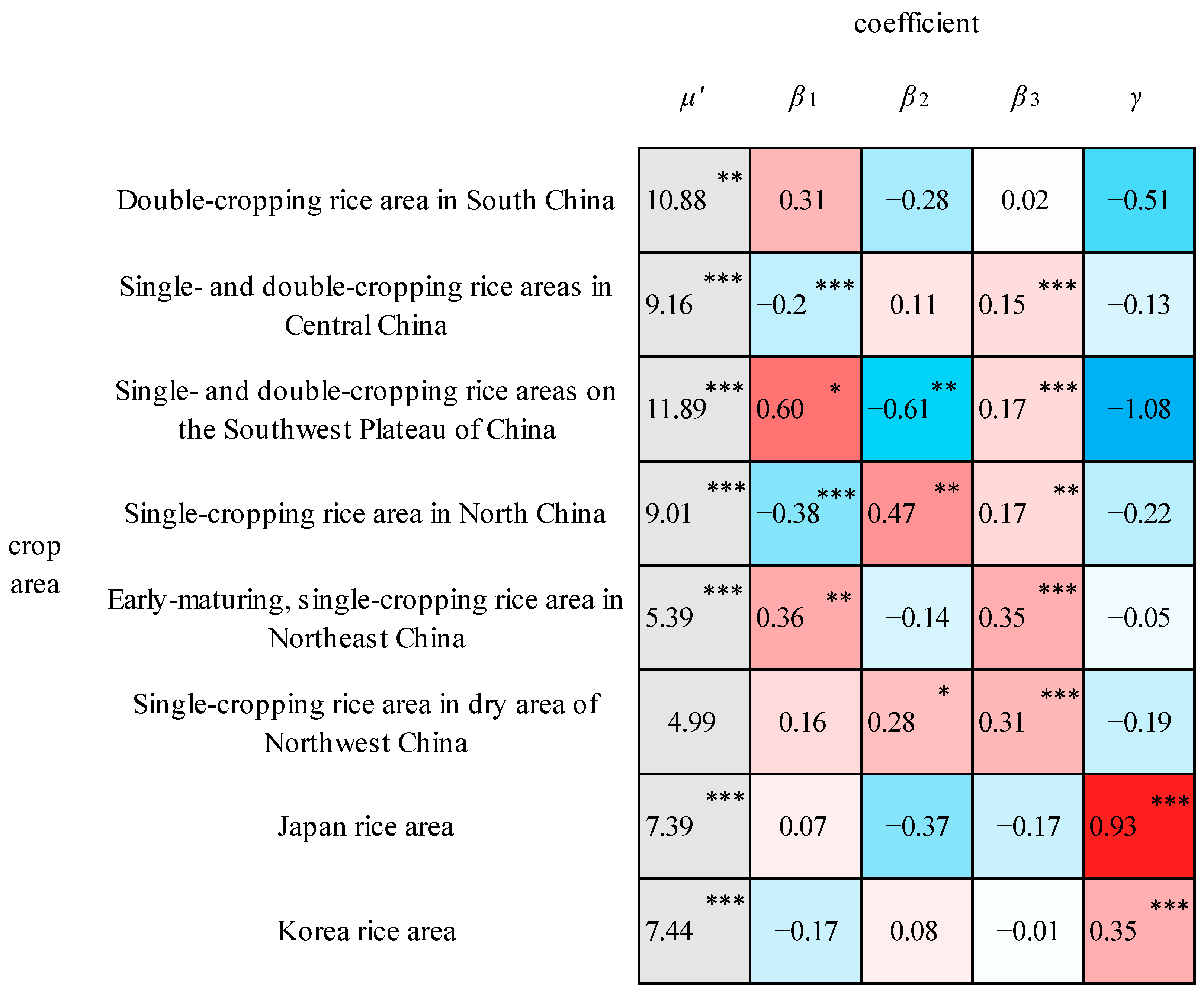
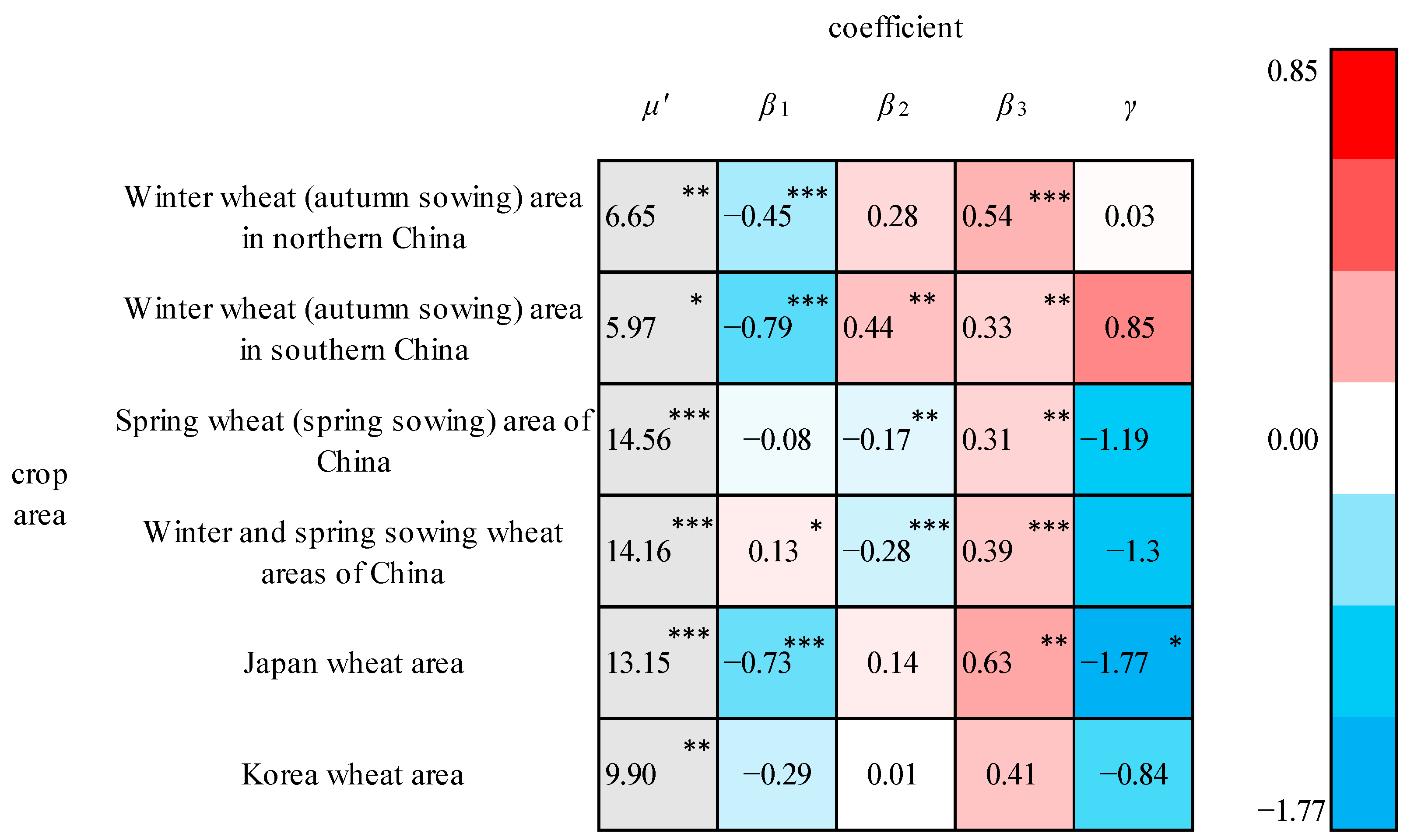
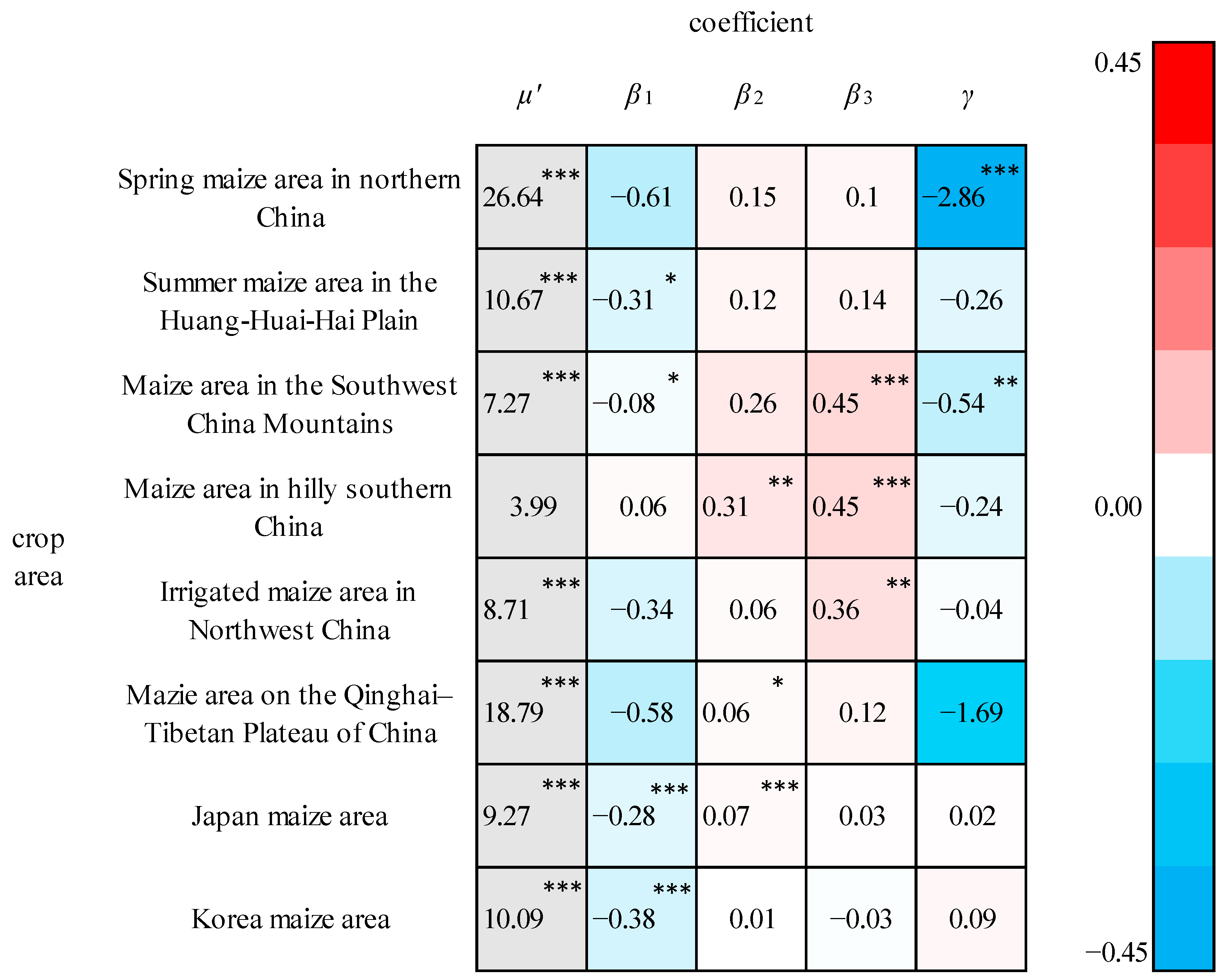
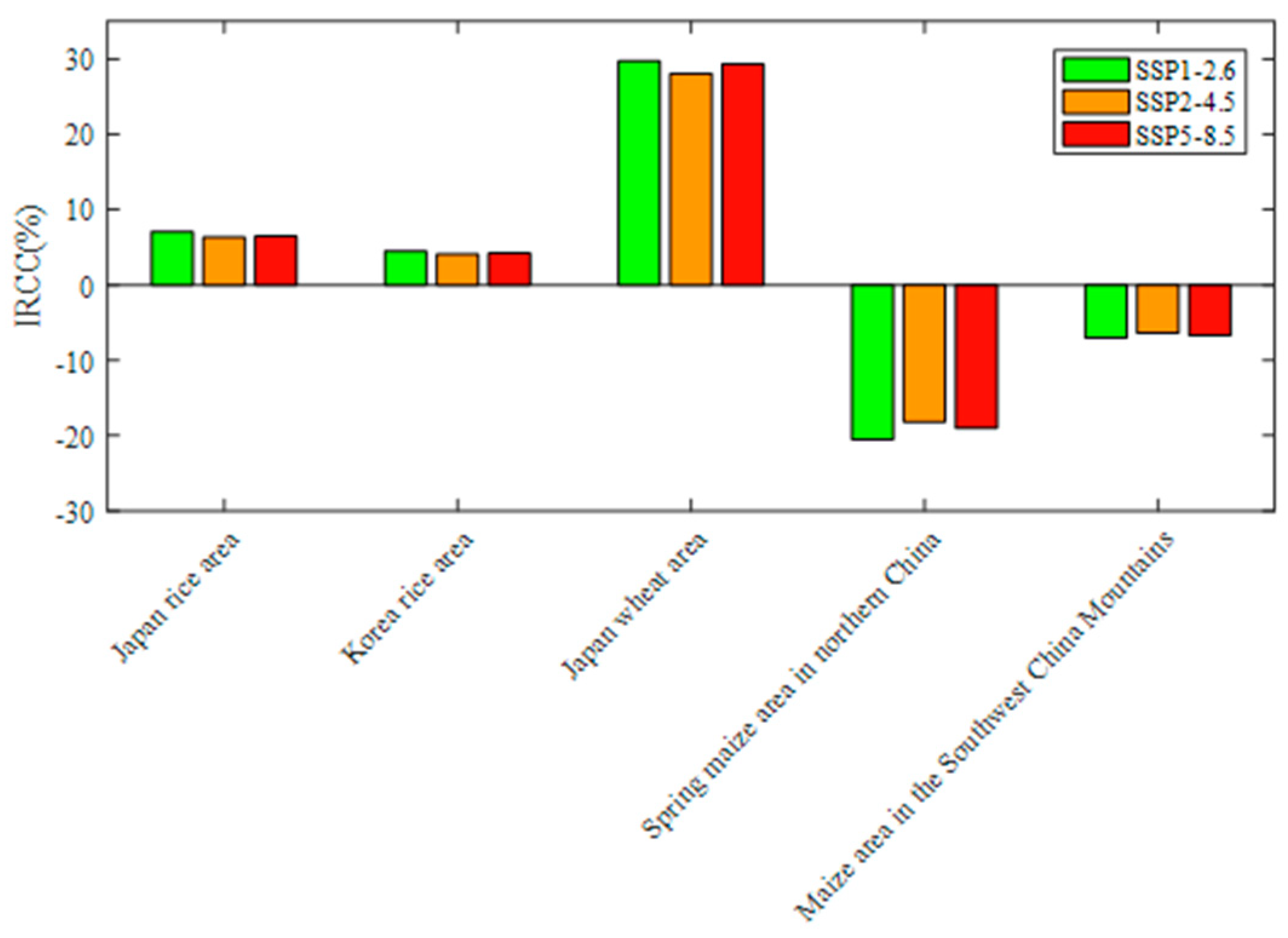
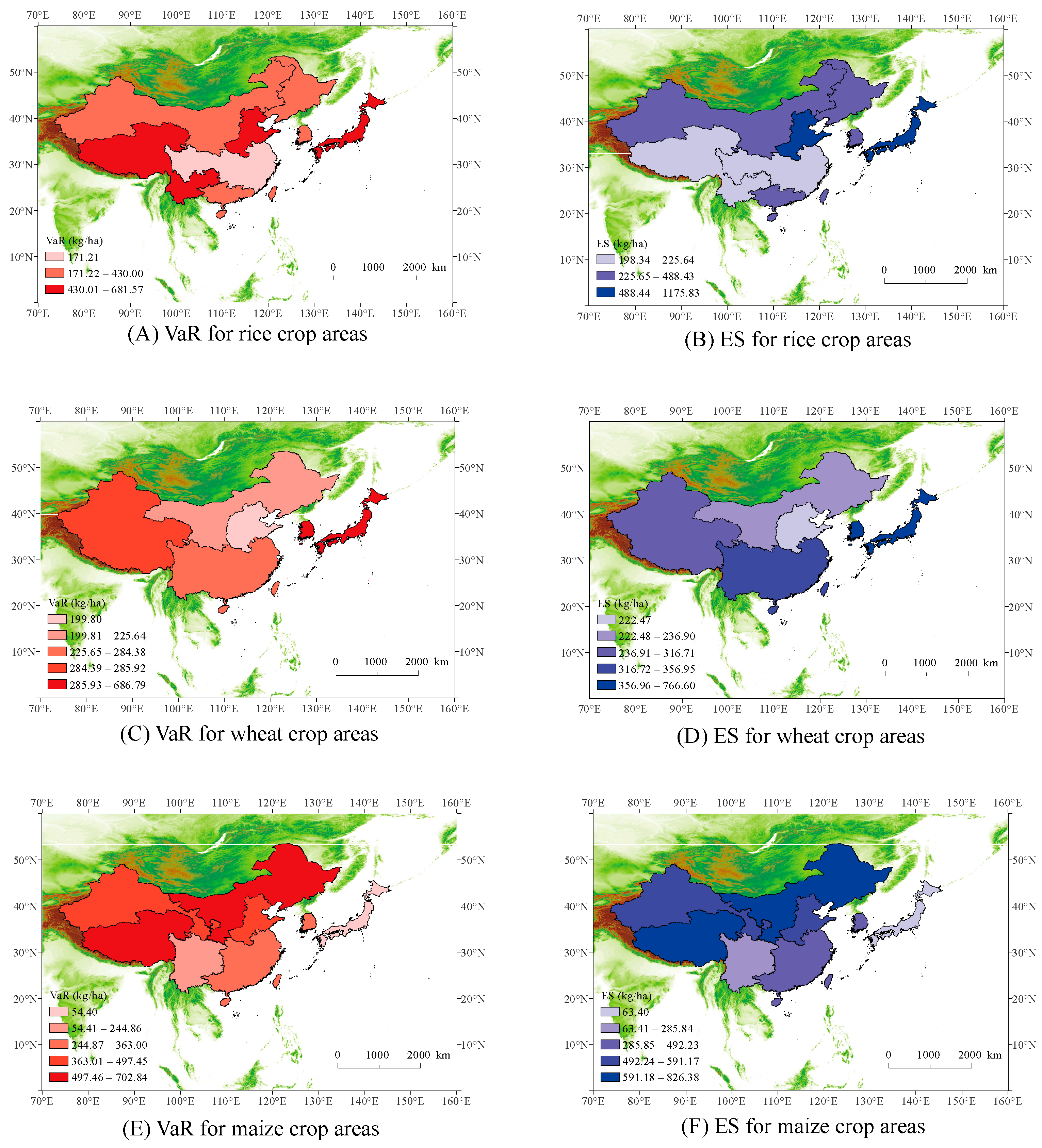
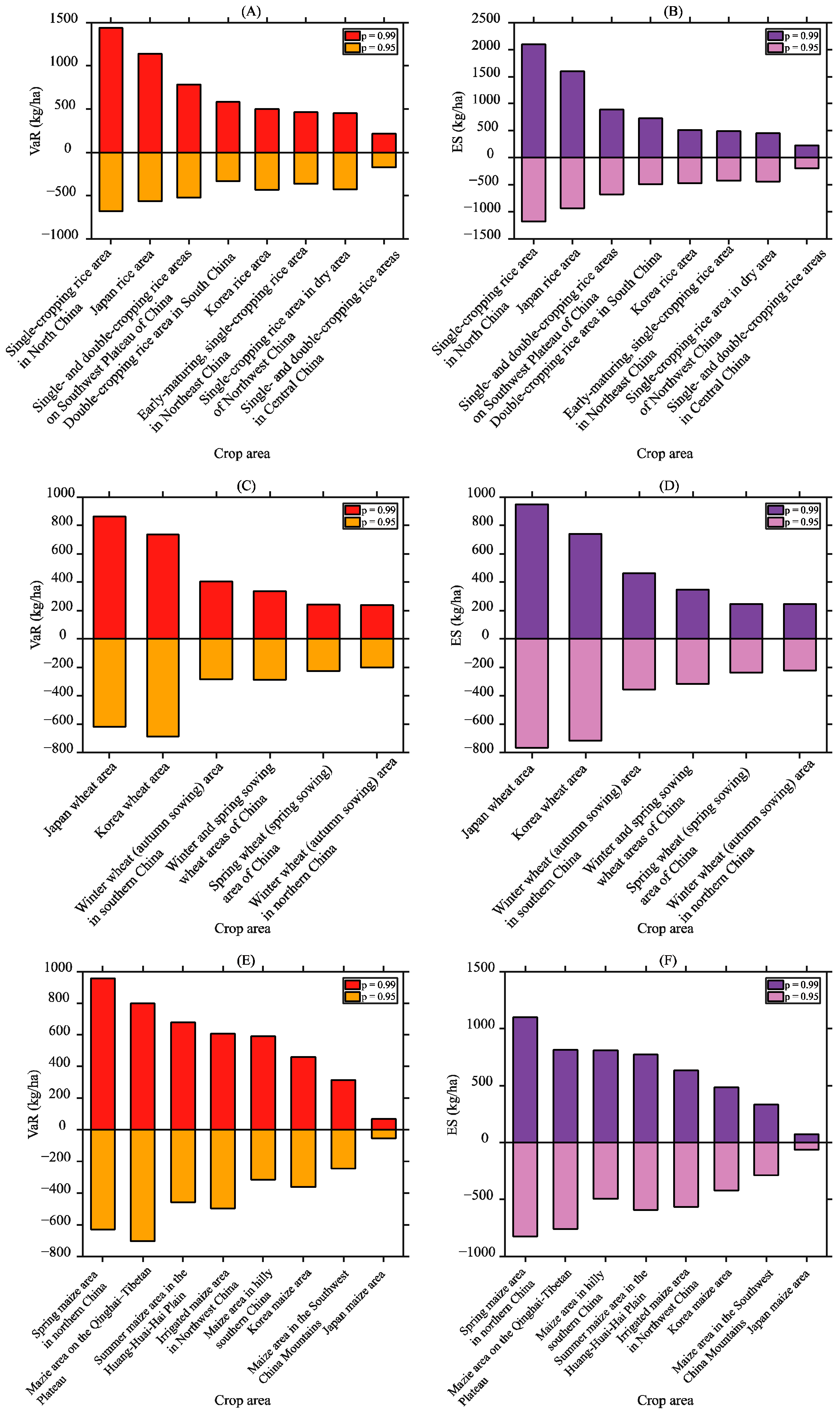
| Crop | Serial Number | Crop Area | Geographical Areas | Growing Period |
|---|---|---|---|---|
| Rice | 1 | Double-cropping rice area in South China | Guangdong, Guangxi, Hainan, Hong Kong, Macao, and Taiwan | 5–7, 8–10 |
| 2 | Single- and double-cropping rice areas in Central China | Jiangsu, Fujian, Shanghai, Zhejiang, Anhui, Jiangxi, Hunan, Hubei, Sichuan, and Chongqing | 5–7, 8–10 | |
| 3 | Single- and double-cropping rice areas on the Southwest Plateau of China | Guizhou, Yunnan, Tibet, and Qinghai | 5–7, 8–10 | |
| 4 | Single-cropping rice area in North China | Beijing, Tianjin, Shandong, Hebei, and Henan | 6–8 | |
| 5 | Early-maturing, single-cropping rice area in Northeast China | Heilongjiang, Jilin, and Liaoning | 6–8 | |
| 6 | Single-cropping rice area in dry area of Northwest China | Xinjiang, Ningxia, Gansu, Inner Mongolia, Shanxi, and Shaanxi | 6–8 | |
| 7 | Japan rice area | 7–8 | ||
| 8 | Korea rice area | 7–8 | ||
| Wheat | 1 | Winter wheat (autumn sowing) area in northern China | Shandong, Henan, Hebei, Shanxi, Beijing, and Tianjin | (-) 1 11–5 |
| 2 | Winter wheat (autumn sowing) area in southern China | Fujian, Jiangxi, Guangdong, Hainan, Guangxi, Hunan, Hubei, Guizhou, Yunnan, Sichuan, Chongqing, Jiangsu, Anhui, Hong Kong, Macao, Taiwan, Zhejiang, and Shanghai | (-) 11–5 | |
| 3 | Spring wheat (spring sowing) area of China | Heilongjiang, Jilin, Liaoning, Inner Mongolia, Ningxia, Shaanxi, and Gansu | 5–8 | |
| 4 | Winter and spring sowing wheat areas of China | Xinjiang, Tibet, and Qinghai | (-) 11–5, 5–8 | |
| 5 | Japan wheat area | (-) 12–5 | ||
| 6 | Korea wheat area | (-) 11–5 | ||
| Maize | 1 | Spring maize area in northern China | Heilongjiang, Jilin, Liaoning, Inner Mongolia, Shanxi, Shaanxi, and Ningxia | 5–9 |
| 2 | Summer maize area in the Huang-Huai-Hai Plain | Hebei, Tianjin, Beijing, Henan, and Shandong | 7–9 | |
| 3 | Maize area in the Southwest China Mountains | Sichuan, Chongqing, Guizhou, and Yunnan | 6–8 | |
| 4 | Maize area in hilly southern China | Hubei, Anhui, Jiangsu, Shanghai, Zhejiang, Hunan, Jiangxi, Fujian, Guangdong, Guangxi, Hainan, Hong Kong, Macao, and Taiwan | 6–7 | |
| 5 | Irrigated maize area in Northwest China | Xinjiang and Gansu | 6–9 | |
| 6 | Mazie area on the Qinghai–Tibetan Plateau of China | Qinghai and Tibet | 6–9 | |
| 7 | Japan maize area | 5–8 | ||
| 8 | Korea maize area | 4–8 |
| Cropping Area | 1 1 | 2 | 3 | 4 | 5 | 6 | 7 | 8 | |
|---|---|---|---|---|---|---|---|---|---|
| Maize | Threshold | −31.62 | −187.12 | −128.88 | −38.62 | −324.12 | −142.19 | −27.97 | −170.82 |
| Sorting | 16 | 5 | 5 | 19 | 4 | 10 | 5 | 6 | |
| Rice | Threshold | −182.32 | −101.21 | −275.18 | −214.27 | −87.64 | −313.04 | −185.19 | −256.75 |
| Sorting | 5 | 4 | 3 | 5 | 10 | 5 | 5 | 5 | |
| Wheat | Threshold | −120.93 | −120.78 | 55.76 | −122.59 | −237.00 | −312.26 | - | - |
| Sorting | 4 | 6 | 19 | 8 | 7 | 7 | - | - | |
| Crop Area | Residual Sum of Squares (RSS) | Adjusted R2 | Mean of Relative Error |
|---|---|---|---|
| Double-cropping rice area in South China | 0.0710 | 0.2803 | −0.0077 |
| Single- and double-cropping rice areas in Central China | 0.0083 | 0.8972 | −0.0012 |
| Single- and double-cropping rice areas on the Southwest Plateau of China | 0.0710 | 0.4274 | 0.0191 |
| Single-cropping rice area in North China | 0.1189 | 0.6829 | 0.0341 |
| Early-maturing single-cropping rice area in Northeast China | 0.0315 | 0.7660 | −0.0014 |
| Single-cropping rice area in dry area of Northwest China | 0.0721 | 0.8128 | 0.0114 |
| Japan rice area | 0.0661 | 0.6327 | 0.0046 |
| Korea rice area | 0.0397 | 0.5443 | 0.0063 |
| Winter wheat (autumn sowing) area in northern China | 0.0270 | 0.9593 | −0.0064 |
| Winter wheat (autumn sowing) area in southern China | 0.0853 | 0.9056 | 0.0056 |
| Spring wheat (spring sowing) area of China | 0.1067 | 0.7978 | 0.0090 |
| Winter and spring sowing wheat areas of China | 0.0273 | 0.9445 | 0.0140 |
| Japan wheat area | 0.2909 | 0.3555 | 0.0111 |
| Korea wheat area | 0.5379 | −0.0146 | −0.0039 |
| Spring maize area in northern China | 0.0876 | 0.7334 | 0.0046 |
| Summer maize area in the Huang-Huai-Hai Plain | 0.0933 | 0.6751 | 0.0069 |
| Maize area in the Southwest China Mountains | 0.0578 | 0.8775 | 0.0114 |
| Maize area in hilly southern China | 0.0704 | 0.8291 | 0.0261 |
| Irrigated maize area in Northwest China | 0.0994 | 0.7696 | −0.0071 |
| Mazie area on the Qinghai–Tibetan Plateau of China | 0.2295 | 0.4881 | 0.0150 |
| Japan maize area | 0.0027 | 0.9117 | 0.0034 |
| Korea maize area | 0.0904 | 0.7355 | 0.0014 |
| Crop Area | β1 | β2 | β3 | γ |
|---|---|---|---|---|
| Double-cropping rice area in South China | 1.1945 | 8.2247 | 8.6717 | 1.1898 |
| Single- and double-cropping rice areas in Central China | 2.4871 | 2.2701 | 2.9919 | 1.1801 |
| Single- and double-cropping rice areas on the Southwest Plateau of China | 3.6948 | 2.0385 | 3.0412 | 1.4064 |
| Single-cropping rice area in North China | 1.8717 | 1.2607 | 1.6227 | 1.1130 |
| Early-maturing, single-cropping rice area in Northeast China | 2.5946 | 31.3800 | 25.0936 | 1.0502 |
| Single-cropping rice area in dry area of Northwest China | 1.9516 | 1.3012 | 1.8670 | 1.3341 |
| Japan rice area | 11.4393 | 9.3500 | 6.6507 | 1.0939 |
| Korea rice area | 26.2476 | 17.9801 | 4.1156 | 1.0629 |
| Winter wheat (autumn sowing) area in northern China | 2.2262 | 1.4196 | 2.3437 | 1.1729 |
| Winter wheat (autumn sowing) area in southern China | 2.4213 | 2.7505 | 4.2112 | 1.6201 |
| Spring wheat (spring sowing) area of China | 1.3803 | 4.5462 | 4.6765 | 1.1909 |
| Winter and spring sowing wheat areas of China | 1.9761 | 1.0311 | 1.9356 | 1.0335 |
| Japan wheat area | 6.7006 | 1.4523 | 6.6055 | 1.1486 |
| Korea wheat area | 8.1970 | 4.6529 | 3.5710 | 1.0648 |
| Spring maize area in northern China | 2.4236 | 11.7103 | 9.0062 | 1.2765 |
| Summer maize area in the Huang-Huai-Hai Plain | 5.1883 | 8.7393 | 3.0180 | 1.0175 |
| Maize area in the Southwest China Mountains | 4.6703 | 6.2971 | 2.6591 | 1.1282 |
| Maize area in hilly southern China | 13.1194 | 7.6808 | 4.8837 | 1.3908 |
| Irrigated maize area in Northwest China | 1.6665 | 9.8974 | 14.1108 | 1.8945 |
| Mazie area on the Qinghai–Tibetan Plateau of China | 1.4767 | 2.1175 | 1.8110 | 1.3394 |
| Japan maize area | 9.0438 | 3.1719 | 6.3990 | 1.0870 |
| Korea maize area | 4.1217 | 2.2174 | 3.6954 | 1.1033 |
| Crop Area | Estimation Method | μ′ | β1 | β2 | β3 | γ |
|---|---|---|---|---|---|---|
| Early-maturing, single-cropping rice area in Northeast China | OLS | 5.39 *** 1 | 0.36 ** | −0.14 | 0.35 *** | −0.05 |
| RR (k = 0.19) | 6.55 *** | 0.18 | 0.05 *** | 0.11 *** | 0.02 | |
| Japan rice area | OLS | 7.39 *** | 0.07 | −0.37 | −0.17 | 0.93 *** |
| RR (k = 0.08) | 7.23 *** | −0.03 | −0.24 * | −0.13 | 0.82 *** | |
| Korea rice area | OLS | 7.44 *** | −0.17 | 0.08 | −0.01 | 0.35 *** |
| RR (k = 0.15) | 8.19 *** | −0.07 ** | −0.06 | −0.04 | 0.32 *** | |
| Spring maize area in northern China | OLS | 26.64 *** | −0.61 | 0.15 | 0.10 | −2.86 *** |
| RR (k = 0.15) | 25.62 *** | −0.73 ** | 0.11 *** | 0.12 ** | −2.42 *** | |
| Maize area in hilly southern China | OLS | 3.99 | 0.06 | 0.31 ** | 0.45 *** | −0.24 |
| RR (k = 0.12) | 7.38 *** | −0.18 ** | 0.21 *** | 0.32 *** | −0.17 | |
| Irrigated maize area in Northwest China | OLS | 8.71 *** | −0.34 | 0.06 | 0.36 ** | −0.04 |
| RR (k = 0.19) | 8.20 *** | −0.14 | 0.13 *** | 0.19 *** | −0.27 |
| Crop Area | μ′ | β1 | β2 | β3 | γ | b1 | b2 |
|---|---|---|---|---|---|---|---|
| Double-cropping rice area in South China | 3.41 | 0.86 ** 1 | −0.18 | 0.13 | −0.18 | −0.11 *** | −0.04 |
| Single- and double-cropping rice areas in Central China | 11.02 *** | −0.19 *** | −0.10 | 0.16 *** | −0.07 | −0.04 * | −0.03 |
| Single- and double-cropping rice areas on the Southwest Plateau of China | 16.40 *** | −0.14 | −0.42 | 0.29 ** | −1.21 | −0.01 | −0.11 |
| Single-cropping rice area in North China | 9.75 *** | −0.49 *** | 0.17 | 0.41 *** | −0.01 | −0.13 * | −0.13 * |
| Early-maturing, single-cropping rice area in Northeast China | 5.47 *** | 0.25 | 0.06 | 0.23 ** | −0.05 | −0.03 | −0.01 |
| Single-cropping rice area in dry area of Northwest China | 5.66 | 0.13 | 0.53 *** | 0.24 *** | −0.46 | 0.10 ** | 0.14 * |
| Japan rice area | 8.14 *** | 0.07 | −0.48 ** | −0.16 | 0.92 *** | −0.04 | −0.02 |
| Korea rice area | 7.91 *** | −0.21 | 0.07 | −0.03 | 0.33 *** | −0.02 | −0.03 |
| Winter wheat (autumn sowing) area in northern China | 7.26 ** | −0.42 *** | 0.18 | 0.53 *** | 0.04 | −0.01 | 0.02 |
| Winter wheat (autumn sowing) area in southern China | 6.15 | −0.81 *** | 0.44 | 0.33 ** | 0.84 | 0.00 2 | −0.01 |
| Spring wheat (spring sowing) area of China | 14.00 *** | 0.01 | −0.24 * | 0.28 * | −1.07 | −0.05 | −0.04 |
| Winter and spring sowing wheat areas of China | 12.50 *** | 0.12 * | −0.16 *** | 0.44 *** | −1.18 | 0.03 | −0.04 |
| Japan wheat area | 12.61 *** | −0.48 | 0.04 | 0.60 * | −1.87 * | 0.08 | 0.14 |
| Korea wheat area | 12.02 ** | −0.72 * | −0.01 | 0.35 | −0.65 | −0.13 | −0.28 |
| Spring maize area in northern China | 25.66 *** | −0.52 | 0.11 | 0.09 | −2.73 *** | 0.01 | 0.04 |
| Summer maize area in the Huang-Huai-Hai Plain | 10.32 *** | −0.32 * | 0.17 | 0.13 | −0.24 | 0.00 | −0.02 |
| Maize area in the Southwest China Mountains | 7.56 *** | −0.10 | 0.35 * | 0.32 ** | −0.59 ** | 0.05 | 0.02 |
| Maize area in hilly southern China | 3.35 | 0.23 | 0.30 * | 0.41 ** | −0.38 | 0.06 | 0.08 |
| Irrigated maize area in Northwest China | 9.77 *** | −0.40 * | −0.05 | 0.37 ** | −0.05 | 0.04 | 0.10 |
| Mazie area on the Qinghai–Tibetan Plateau of China | 19.46 *** | −0.72 | 0.26 *** | 0.02 | −1.64 | 0.00 | −0.32 ** |
| Japan maize area | 9.02 *** | −0.24 *** | 0.06 *** | 0.03 | 0.03 | 0.00 | 0.01 |
| Korea maize area | 10.56 *** | −0.45 *** | 0.02 | −0.03 | 0.07 | −0.01 | −0.05 |
Disclaimer/Publisher’s Note: The statements, opinions and data contained in all publications are solely those of the individual author(s) and contributor(s) and not of MDPI and/or the editor(s). MDPI and/or the editor(s) disclaim responsibility for any injury to people or property resulting from any ideas, methods, instructions or products referred to in the content. |
© 2024 by the authors. Licensee MDPI, Basel, Switzerland. This article is an open access article distributed under the terms and conditions of the Creative Commons Attribution (CC BY) license (https://creativecommons.org/licenses/by/4.0/).
Share and Cite
Chou, J.; Jin, H.; Xu, Y.; Zhao, W.; Li, Y.; Hao, Y. Impacts and Risk Assessments of Climate Change for the Yields of the Major Grain Crops in China, Japan, and Korea. Foods 2024, 13, 966. https://doi.org/10.3390/foods13060966
Chou J, Jin H, Xu Y, Zhao W, Li Y, Hao Y. Impacts and Risk Assessments of Climate Change for the Yields of the Major Grain Crops in China, Japan, and Korea. Foods. 2024; 13(6):966. https://doi.org/10.3390/foods13060966
Chicago/Turabian StyleChou, Jieming, Haofeng Jin, Yuan Xu, Weixing Zhao, Yuanmeng Li, and Yidan Hao. 2024. "Impacts and Risk Assessments of Climate Change for the Yields of the Major Grain Crops in China, Japan, and Korea" Foods 13, no. 6: 966. https://doi.org/10.3390/foods13060966
APA StyleChou, J., Jin, H., Xu, Y., Zhao, W., Li, Y., & Hao, Y. (2024). Impacts and Risk Assessments of Climate Change for the Yields of the Major Grain Crops in China, Japan, and Korea. Foods, 13(6), 966. https://doi.org/10.3390/foods13060966






